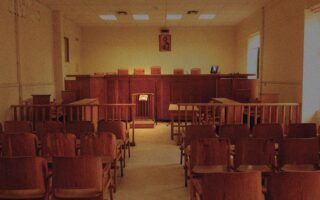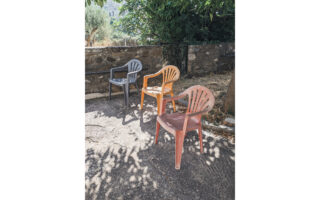Greek artist’s mural honoring scientists in Pfizer’s NYC lobby up for grabs

A mural by a Greek-born artist honoring ancient and modern figures in medicine that has hung in the lobby of Pfizer’s original New York City headquarters for more than 60 years could soon end up in pieces if conservationists can’t find a new home for it in the next few weeks.
“Medical Research Through the Ages,” a massive metal and tile mosaic depicting scientists and lab equipment, has been visible through the high glass-windowed lobby of the pharmaceutical giant’s midtown Manhattan office since the 1960s.
But the building is being gutted and converted into residential apartments, and the new owners have given the mural a move-out date of as soon as September 10.
Art conservationists and the late artist’s daughters are now scrambling to find a patron who is able to cover the tens of thousands of dollars they estimate it will take to move and remount it, as well as an institution that can display it.
“I would ideally like to see it as part of an educational future, whether it’s on a hospital campus as part of a school or a college. Or part of a larger public art program for the citizens of New York City,” said art historian and urban planner Andrew Cronson, one of the people trying to find a new home for the piece.
The 11-meter-wide by 4.3 meter-high mural by Greek American artist Nikos Bel-Jon was the main showpiece of Pfizer’s world headquarters when the building opened a few blocks from Grand Central Terminal in 1961, at a time when flashy buildings and grand corporate art projects were a symbol of business success. He died in 1966, leaving behind dozens of large brushed-metal works commissioned by companies and private institutions, many of which have now been lost or destroyed.
Bel-Jon, born Nikolaos Fotios Baloyannis in the historic village of Valtesiniko, Arcadia, in 1911, studied at the Athens School of Fine Arts in Athens and the Ecole des Beaux-Arts and the Ecole du Louvre in Paris. He emigrated to the US in 1946.

This undated photo shows Nikos Bel-Jon in his New York Studio on East 72 Street in front of a model of the massive metal mural he built for Pfizer’s world headquarters in 1961. [Rhea Bel-Jon Calkins via AP]
In recent years, Pfizer sold the building – and last year moved its headquarters to a shared office space in a newer property. The company said in an emailed statement that it decided the money needed to deconstruct, relocate and reinstall the mural elsewhere would be better spent on “patient-related priorities.”
The developer now turning the building into apartments, Metro Loft, doesn’t want to keep the artwork either, though it has been working with those trying to save the piece with help like letting art appraisers in. The company declined to comment further, but Jack Berman, its director of operations, confirmed in an email that it needs to get the mural out.
Bel-Jon’s youngest daughter, Rhea Bel-Jon Calkins, said they’ve gotten some interest from universities who could take the piece, and a Greek cultural organization that could help fundraise for the move. But the removal alone could cost between $20,000 and $50,000, according to estimates cited by Cronson.
If they can’t immediately find a taker, the mural won’t end up in landfill, Bel-Jon Calkins said. But it would have to be broken up into pieces – nine metal sections and eight mosaic sections – and moved into storage, likely with some of her relatives.
Time is ticking away. Workers gutting the building have been carrying out ripped-up carpeting, drab office chairs and piles of scrap wood and loading them into garbage trucks.
For the past few decades, the artwork’s metal – brushed tin and aluminum panels in the shape of laboratory beakers, funnels and flasks, surrounded by symbols, alchemists and scientists – has been a dull gray and white. But Bel-Jon Calkins remembers its original, multicolored lighting scheme.
“As you moved, the color moved with you and changed. So there was a constant dynamic to the mural that no one really has ever been able to achieve,” she said.
Richard McCoy, director of the Indiana nonprofit Landmark Columbus Foundation, which cares for local buildings and landscapes, said the piece might lack commercial value, describing Bel-Jon as “extraordinary, but not super well-known.”
“But then you realize 20 or 30 years from then how great it was,” he said, adding that it might merit preservation for its historical value.
Bel-Jon Calkins tracks her father’s 42 large-scale metal murals in a spreadsheet and on the artist’s website. She said only about a dozen are confirmed to exist.
A 3.6-meter metal mosaic depicting saints and commissioned by a Greek Orthodox church in San Francisco was destroyed in the Loma Prieta earthquake of 1989. General Motors commissioned a hubcap-shaped metal mural that was larger than a car for a trade show, but she confirmed it was later melted down into scrap.
“It’s the corporations that have lost them,” she said in a phone conversation from her home in San Miguel de Allende, Mexico. “They valued them enough to commission them but not enough to preserve them.” [AP, Kathimerini]





